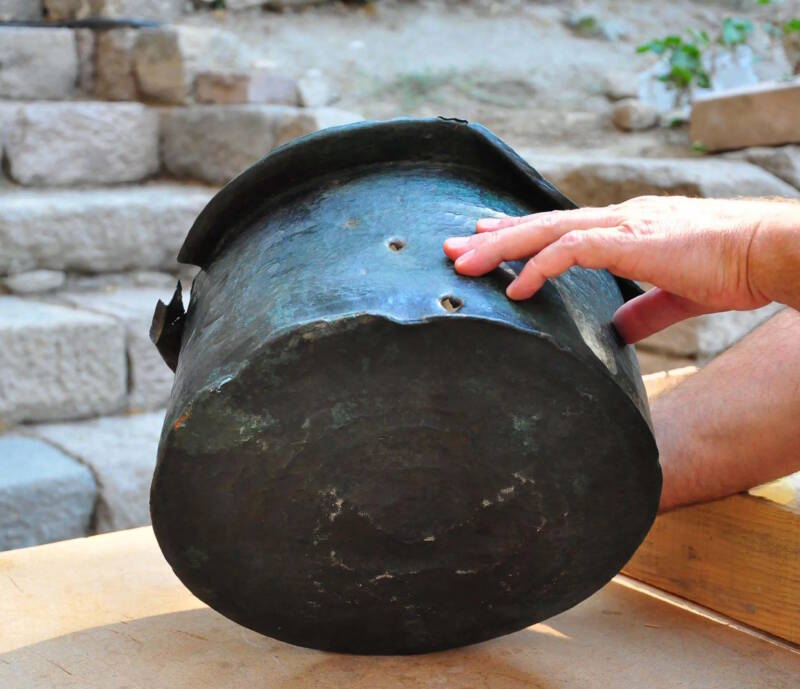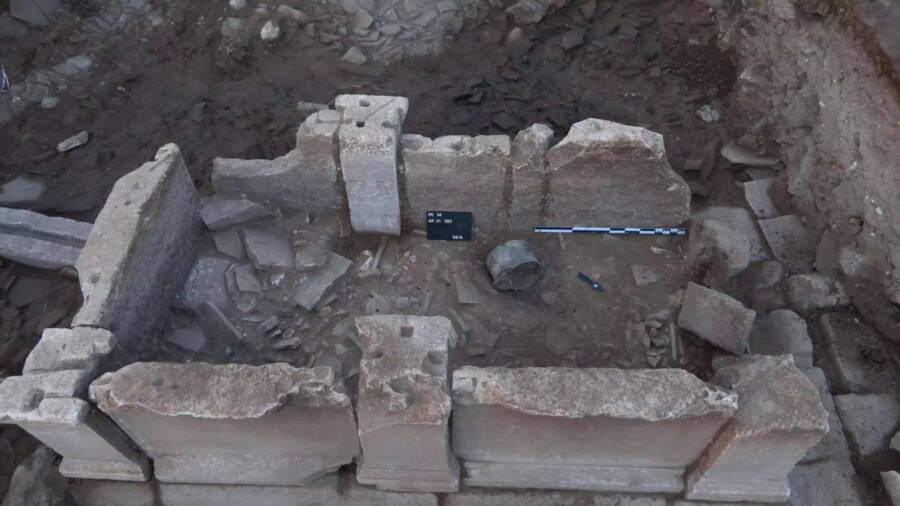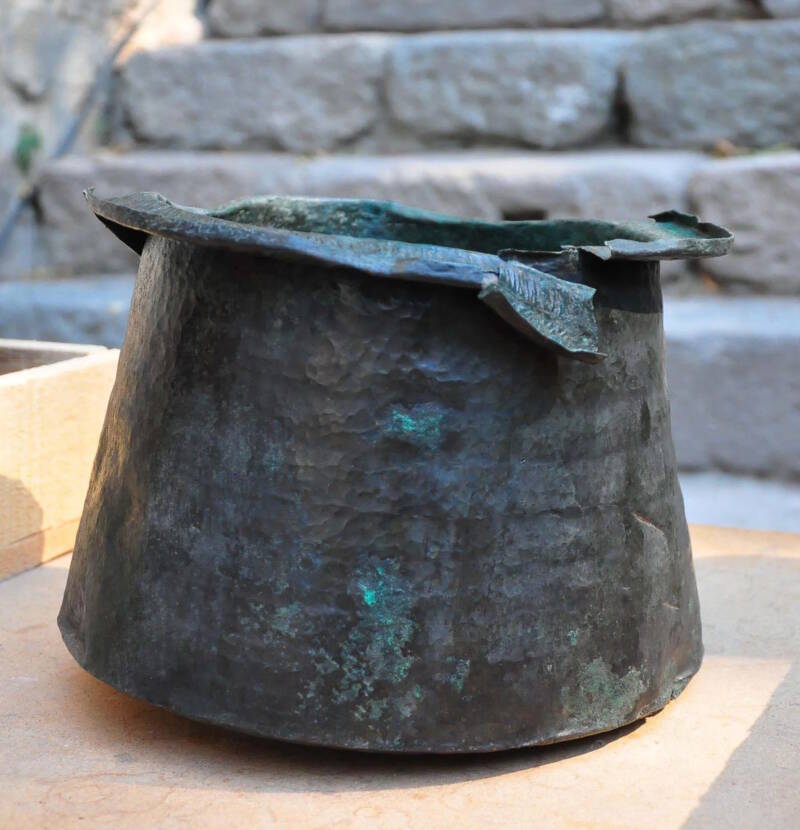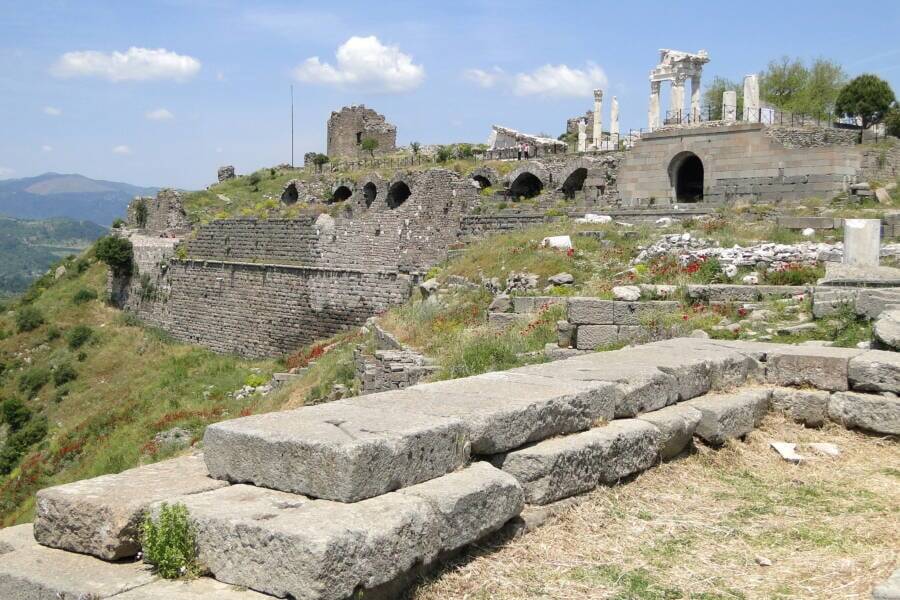The cauldron, which was likely used to transport water for domestic use, has been lying undisturbed since the Mosaic House was abandoned in the seventh century C.E.

DHAThe 1,400-year-old bronze cauldron was found untouched in its original location.
Archaeologists in Turkey recently discovered an exceptionally well-preserved bronze cauldron dating back around 1,400 years.
It was uncovered in its original position in a complex known as the “Mosaic House,” marking the latest find from the Ministry of Culture and Tourism’s “Heritage for the Future” initiative.
A Well-Preserved Artifact From An Ancient Pool
The cauldron was found in a courtyard at the Mosaic House inside a large pool with a mosaic floor. Based on its location, archaeologists determined the cauldron was likely used to collect rain or spring water.
It has not been touched since the site was abandoned during the seventh century C.E.
“This cauldron stands out not only for the quality of its material but also for its preserved position and craftsmanship,” said Dr. Yusuf Sezgin, the excavation leader and the head of the archaeology department at Manisa Celal Bayar University, as reported by Anatolian Archaeology.
“It was produced using a hammering technique, remarkably similar to traditional bronze working methods still practiced today,” Sezgin continued. “This find proves that traditional Anatolian bronze craftsmanship has remained nearly unchanged for over a millennium.”

DHAThe pool in which the cauldron was discovered.
Bronze was a costly material in antiquity and was generally reserved for special purposes.
“Bronze was an important material, especially in structures of this type, in antiquity,” Sezgin said. “The most commonly used materials in daily life were terracotta, or ceramic products. However, bronze is an expensive and valuable material. Therefore, it was used in more specialized areas and for specific purposes.”
Its use here suggests a potential purpose beyond simple everyday function, possibly as a vessel to hold water used in ritual cleansings. The remains of a kitchen structure near the courtyard could also indicate that the cauldron was used to transport water from the pool.

DHAThe cauldron seems to have been left in the pool when the house was abandoned.
In either case, Sezgin emphasized the importance of the find for understanding the daily lives of Turkey’s ancient denizens: “The fact that it was found exactly in its original position, untouched for centuries, gives us direct insight into the cultural practices, technological capabilities, and daily routines of that era.”
It is just the latest example of how the Heritage for the Future initiative has led to significant archaeological discoveries at the Mosaic House.
Additional Archaeological Finds At Turkey’s Mosaic House
The Mosaic House earned its name due to the sheer number of mosaics at the ancient site.
This grand residential complex was built between the second and third centuries C.E. and occupied into the Christian era, when the nearby Red Basilica became a church. It was likely abandoned around the seventh century following a devastating fire during Arab raids.
The Mosaic House features a peristyle courtyard with a stone pool at its center, representing typical Roman architectural design.

Adam Jones/Wikimedia CommonsThe acropolis of Pergamon.
Previous excavations at the site have revealed more about its occupants, including an intact, sealed roof tile that indicated a king once owned the building. Additionally, archaeologists have found other artifacts, such as kitchenware, weaponry, and jewelry, all providing valuable insight into daily life during the Roman period.
The city of Pergamon itself was once intended to be a “Second Athens.” It thrived during the Hellenistic period and boasted one of the most significant libraries of all time, the Library of Pergamon. Likewise, it was rife with architectural marvels, including a monument to Zeus known as the Great Altar of Pergamon.
Prominent pagan dedications like this eventually led to the city’s inclusion in the Book of Revelation, where it is referred to as the location of “Satan’s throne.”
A series of devastating events ultimately saw the city’s abandonment around 663 C.E., after years of raids and earthquakes brought it to the brink of ruin. Today, however, it is proving to be an invaluable source of archaeological discovery, bringing the history of a once great city into modern prominence.
After learning about the cauldron found in Turkey’s Mosaic House, discover the stories of some of history’s most fascinating lost cities. Then, read about 13 sunken cities from around the world.





